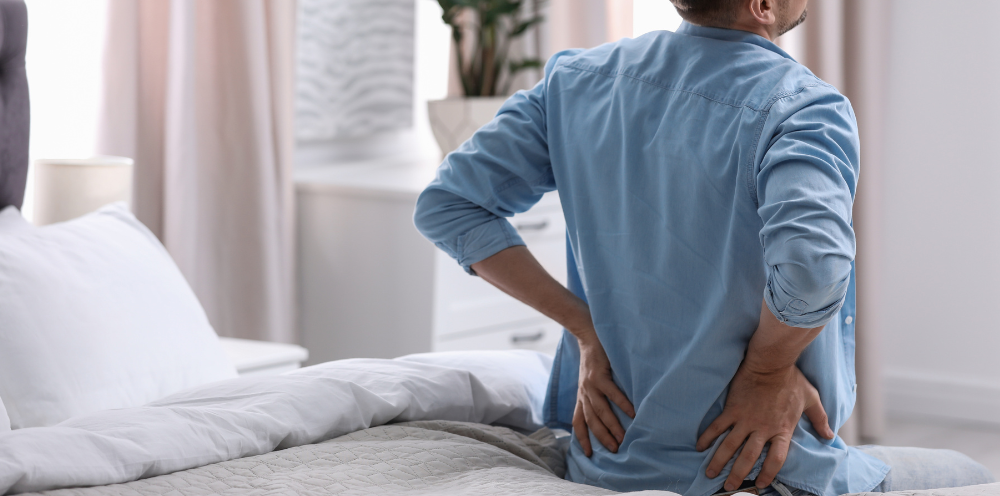Coccydynia
Move Better. Live Fuller. Your Wellness Journey Starts Here.
Schedule a FREE Discovery Call!
What Is Coccydynia?
Coccydynia is a term that means tailbone pain. Your tailbone (the coccyx) is a small structure located at the bottom of your spine that is made up of vertebrae. It helps support your body, and is a critical intersection of ligaments, muscles, and tendons.
The tailbone is one of the few weight-bearing locations in the body, making it an essential part of your body’s support system. It is connected to the pelvic floor—an incredibly important part of your body, which we’ll get into later!
Pain in the tailbone is common but never normal. The pain can be dull and achy, sharp, or even debilitating.

Problems with the tailbone can also cause the following symptoms:
- Pain and discomfort when sitting
- Back pain
- Swelling
- Sciatica
- Pain during bowel movements
- Pain when moving from sitting to standing
- Trouble sleeping
- Pain during sex
What Causes Coccydynia?
Pain and other issues with the tailbone are commonly caused by an injury, especially injuries where an individual has fallen onto their backside. Impact to the tailbone can cause bruising, fracture, or dislocation. However, injury is not the only cause of tailbone pain. Other causes may include:
- Overuse and stress (such as sports or other athletic activities)
- Some types of cancer (such as prostate cancer)
- Sitting for long periods of time
- Spinal misalignment
- Pelvic floor dysfunction
- Bad sitting posture
- Pregnancy or childbirth
- Hemorrhoids
- Age
In some more serious cases of injury, dislocation, or fracture, your provider may suggest surgical removal of your tailbone. This is usually a last resort after other options have failed. Physical therapy is often forgotten as an effective form of treatment and support for problems with the coccyx, but remember to advocate for yourself! Physical therapy can help reduce pain and increase the muscle strength of the area around the tailbone, which can be an effective solution for many people. In the next section, you’ll learn more about how physical therapy can work wonders for tailbone conditions!
Physical Therapy for Coccydynia
As mentioned earlier, the tailbone is an important intersection for many muscles and ligaments—many of which belong to the pelvic floor! The pelvic floor is a group of muscles that support your body and its organs (bladder, bowel, uterus, and more). These muscles provide stability for the body, and allow for important functions such as urination, bowel movements, and sexual activities. The health of the pelvic floor can affect these important functions and other parts of the body, including your tailbone.
In many cases, the pelvic floor muscles can become tight, weak, or uncoordinated—this is known as pelvic floor dysfunction. This dysfunction can cause problems with the tailbone, due to the proximity and relatedness of these two areas of the body. For example, the tailbone may shift in response to muscle tension in the pelvic floor, causing pain and discomfort. Therefore, ensuring your pelvic floor is in optimal health can greatly reduce tailbone pain and prevent future complications.
One form of treatment that your physical therapist may utilize to improve function and health of your pelvic floor is manual therapy. By massaging and stretching the muscles in the area, muscle tension can be reduced significantly and can relieve your tailbone pain as a result. This may be done externally or internally (if you consent to doing so and if your unique condition can benefit from it).
Additionally, your pelvic floor therapist will likely utilize biofeedback and other treatments that will improve your awareness and control of your pelvic floor. Gaining a better understanding of how your pelvic floor contracts and relaxes, as well as controlling these functions will help you better coordinate those muscles and improve any tightness, weakness, or other issues they may have.
In other cases, tailbone pain may result from general misalignment. A physical therapist can perform spinal or joint manipulations to reduce pain and readjust the body as needed.
In any case, your pelvic floor physical therapist will create a customized care plan that best suits your individual case and unique needs. They will examine the health of your tailbone, determine the possible causes for your condition, and curate a combination of treatments that will best address your pain. At Hive Therapy and Wellness, our physical therapists may use the following treatment techniques:
- Neuromuscular re-education
- Manual therapy
- Exercise prescription
- Dry needling
- Cupping
- Behavioral modifications
- Electrical muscle stimulation
- Spinal manipulation
- Therapeutic modalities
- Biofeedback
Coccydynia is a term that means tailbone pain. Your tailbone (the coccyx) is a small structure located at the bottom of your spine that is made up of vertebrae. It helps support your body, and is a critical intersection of ligaments, muscles, and tendons.
The tailbone is one of the few weight-bearing locations in the body, making it an essential part of your body’s support system. It is connected to the pelvic floor—an incredibly important part of your body, which we’ll get into later!
Pain in the tailbone is common but never normal. The pain can be dull and achy, sharp, or even debilitating. Problems with the tailbone can also cause the following symptoms:
- Pain and discomfort when sitting
- Back pain
- Swelling
- Sciatica
- Pain during bowel movements
- Pain when moving from sitting to standing
- Trouble sleeping
- Pain during sex
Pain and other issues with the tailbone are commonly caused by an injury, especially injuries where an individual has fallen onto their backside. Impact to the tailbone can cause bruising, fracture, or dislocation. However, injury is not the only cause of tailbone pain. Other causes may include:
- Overuse and stress (such as sports or other athletic activities)
- Some types of cancer (such as prostate cancer)
- Sitting for long periods of time
- Spinal misalignment
- Pelvic floor dysfunction
- Bad sitting posture
- Pregnancy or childbirth
- Hemorrhoids
- Age
In some more serious cases of injury, dislocation, or fracture, your provider may suggest surgical removal of your tailbone. This is usually a last resort after other options have failed.
Physical therapy is often forgotten as an effective form of treatment and support for problems with the coccyx, but remember to advocate for yourself!
Physical therapy can help reduce pain and increase the muscle strength of the area around the tailbone, which can be an effective solution for many people.
In the next section, you’ll learn more about how physical therapy can work wonders for tailbone conditions!
As mentioned earlier, the tailbone is an important intersection for many muscles and ligaments—many of which belong to the pelvic floor! The pelvic floor is a group of muscles that support your body and its organs (bladder, bowel, uterus, and more).
These muscles provide stability for the body, and allow for important functions such as urination, bowel movements, and sexual activities. The health of the pelvic floor can affect these important functions and other parts of the body, including your tailbone.
In many cases, the pelvic floor muscles can become tight, weak, or uncoordinated—this is known as pelvic floor dysfunction. This dysfunction can cause problems with the tailbone, due to the proximity and relatedness of these two areas of the body.
For example, the tailbone may shift in response to muscle tension in the pelvic floor, causing pain and discomfort. Therefore, ensuring your pelvic floor is in optimal health can greatly reduce tailbone pain and prevent future complications.
One form of treatment that your physical therapist may utilize to improve function and health of your pelvic floor is manual therapy.
By massaging and stretching the muscles in the area, muscle tension can be reduced significantly and can relieve your tailbone pain as a result. This may be done externally or internally (if you consent to doing so and if your unique condition can benefit from it).
Additionally, your pelvic floor therapist will likely utilize biofeedback and other treatments that will improve your awareness and control of your pelvic floor.
Gaining a better understanding of how your pelvic floor contracts and relaxes, as well as controlling these functions will help you better coordinate those muscles and improve any tightness, weakness, or other issues they may have.
In other cases, tailbone pain may result from general misalignment. A physical therapist can perform spinal or joint manipulations to reduce pain and readjust the body as needed.
In any case, your pelvic floor physical therapist will create a customized care plan that best suits your individual case and unique needs. They will examine the health of your tailbone, determine the possible causes for your condition, and curate a combination of treatments that will best address your pain.
At Hive Therapy and Wellness, our physical therapists may use the following treatment techniques:
- Neuromuscular re-education
- Manual therapy
- Exercise prescription
- Dry needling
- Cupping
- Behavioral modifications
- Electrical muscle stimulation
- Spinal manipulation
- Therapeutic modalities
- Biofeedback
You can learn more about these treatments on our Treatments Page.





